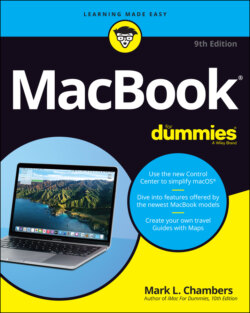Читать книгу MacBook For Dummies - Mark L. Chambers - Страница 22
The holes called ports
ОглавлениеThe next stop on your tour of Planet Laptop is Port Central — those holes on the sides of your computer. Each port connects a different type of cable or device, allowing you to easily add all sorts of functionality to your computer.
Each of these stellar holes has an icon to help you identify it. Here’s a list of what you’ll find and a quick rundown of what these ports do. Although the latest MacBook models carry only USB-C/Thunderbolt 3 ports, I’ve included additional port types that may appear on older MacBooks running macOS Big Sur.
If you need a number of these older ports for different legacy hardware, consider buying a laptop dock that provides multiple ports for your MacBook through a single USB-C or Thunderbolt port. I discuss the laptop dock device in more detail at the end of this chapter.
The following connections are used for external devices and networking:
Thunderbolt 2/Thunderbolt 3 port: The Thunderbolt 2 port (and its faster descendent, Thunderbolt 3) is the expansion racehorse of today’s MacBooks. It offers the fastest data-transfer rates and the ability to add all sorts of peripherals, from external drives to monitors to wired Ethernet connections. (A peripheral is another silly techno-nerd term that means a separate device you connect to your computer.) Thunderbolt 3 devices are somewhat more expensive than their Thunderbolt 2 and USB cousins, but prices are dropping as more Thunderbolt 3 peripherals arrive on the market. Although Thunderbolt-compatible monitors are available, they’re significantly more expensive than standard displays. Luckily, you can also buy an adapter for this port that allows you to send the video signal from your laptop to another VGA, DVI, or HDMI monitor.
USB port(s): Short for universal serial bus, the familiar USB port is the jack-of-all-trades in today’s world of computer add-ons. Most external devices you want to connect to your laptop (such as portable drives, scanners, and digital cameras) use a USB port, including the iPod touch. (Today’s PCs also include USB ports, allowing you to share external USB peripherals such as optical drives and scanners between your MacBook and your desktop PC.) USB 3.0 connections are much faster than the old USB 2.0 standard, but they still accept USB 2.0 devices running at the slower speed. Get the lowdown on Thunderbolt 2 and 3 and USB ports in Chapter 20. All current MacBook models use the cutting-edge USB-C port that allows you to charge the laptop, connect a Thunderbolt 3 or USB-C device, or connect an external monitor or projector — all from one port! To make the USB 3.0 connection, you’ll need a USB-C–to–USB adapter (about $20) and a USB-C AV Multiport adapter (about $70) to connect an external display.
Ethernet port: Older MacBook Pro laptops used to include a standard Gigabit (10/100/1000) Ethernet port, so the laptop was immediately ready to join your existing wired Ethernet network. But because today’s MacBook Air and MacBook Pro are designed to be completely wireless — as I explain in Chapter 11 — they don’t have a built-in wired Ethernet port. If a wired connection is a necessity, you can add a Thunderbolt–to–Gigabit Ethernet (or USB–to–Gigabit Ethernet) adapter to add a wired network port to your laptop. (Apple sells one for about $35.) Or you can invest in a laptop dock with a wired Ethernet port (which I discuss at the end of this chapter).
SD/SDXC card slot: Your older MacBook Air may include an SD (Secure Digital) or SDXC (Secure Digital Extended Capacity) card slot, allowing you to plug SD or SDXC memory cards from digital cameras, cellphones, and portable devices directly into your laptop.
Headphone/optical output port: Last (but certainly not least), you can send the high-quality audio from your rectangular beast to a set of standard headphones or an optical digital audio device such as a high-end home theater system.
